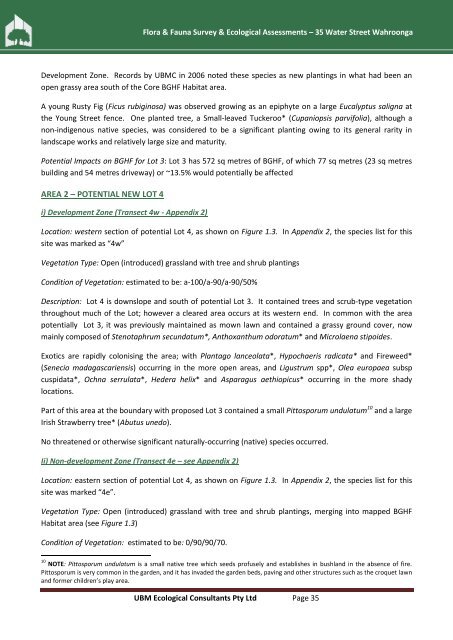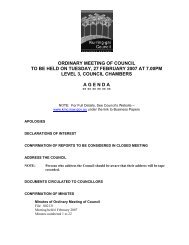Flora & Fauna Survey & Ecological Assessment (pdf. 5MB)
Flora & Fauna Survey & Ecological Assessment (pdf. 5MB)
Flora & Fauna Survey & Ecological Assessment (pdf. 5MB)
Create successful ePaper yourself
Turn your PDF publications into a flip-book with our unique Google optimized e-Paper software.
<strong>Flora</strong> & <strong>Fauna</strong> <strong>Survey</strong> & <strong>Ecological</strong> <strong>Assessment</strong>s – 35 Water Street Wahroonga<br />
Development Zone. Records by UBMC in 2006 noted these species as new plantings in what had been an<br />
open grassy area south of the Core BGHF Habitat area.<br />
A young Rusty Fig (Ficus rubiginosa) was observed growing as an epiphyte on a large Eucalyptus saligna at<br />
the Young Street fence. One planted tree, a Small-leaved Tuckeroo* (Cupaniopsis parvifolia), although a<br />
non-indigenous native species, was considered to be a significant planting owing to its general rarity in<br />
landscape works and relatively large size and maturity.<br />
Potential Impacts on BGHF for Lot 3: Lot 3 has 572 sq metres of BGHF, of which 77 sq metres (23 sq metres<br />
building and 54 metres driveway) or ~13.5% would potentially be affected<br />
AREA 2 – POTENTIAL NEW LOT 4<br />
i) Development Zone (Transect 4w - Appendix 2)<br />
Location: western section of potential Lot 4, as shown on Figure 1.3. In Appendix 2, the species list for this<br />
site was marked as “4w”<br />
Vegetation Type: Open (introduced) grassland with tree and shrub plantings<br />
Condition of Vegetation: estimated to be: a-100/a-90/a-90/50%<br />
Description: Lot 4 is downslope and south of potential Lot 3. It contained trees and scrub-type vegetation<br />
throughout much of the Lot; however a cleared area occurs at its western end. In common with the area<br />
potentially Lot 3, it was previously maintained as mown lawn and contained a grassy ground cover, now<br />
mainly composed of Stenotaphrum secundatum*, Anthoxanthum odoratum* and Microlaena stipoides.<br />
Exotics are rapidly colonising the area; with Plantago lanceolata*, Hypochaeris radicata* and Fireweed*<br />
(Senecio madagascariensis) occurring in the more open areas, and Ligustrum spp*, Olea europaea subsp<br />
cuspidata*, Ochna serrulata*, Hedera helix* and Asparagus aethiopicus* occurring in the more shady<br />
locations.<br />
Part of this area at the boundary with proposed Lot 3 contained a small Pittosporum undulatum 10 and a large<br />
Irish Strawberry tree* (Abutus unedo).<br />
No threatened or otherwise significant naturally-occurring (native) species occurred.<br />
Ii) Non-development Zone (Transect 4e – see Appendix 2)<br />
Location: eastern section of potential Lot 4, as shown on Figure 1.3. In Appendix 2, the species list for this<br />
site was marked “4e”.<br />
Vegetation Type: Open (introduced) grassland with tree and shrub plantings, merging into mapped BGHF<br />
Habitat area (see Figure 1.3)<br />
Condition of Vegetation: estimated to be: 0/90/90/70.<br />
10 NOTE: Pittosporum undulatum is a small native tree which seeds profusely and establishes in bushland in the absence of fire.<br />
Pittosporum is very common in the garden, and it has invaded the garden beds, paving and other structures such as the croquet lawn<br />
and former children’s play area.<br />
UBM <strong>Ecological</strong> Consultants Pty Ltd Page 35

















